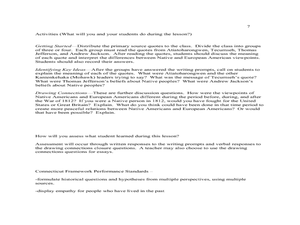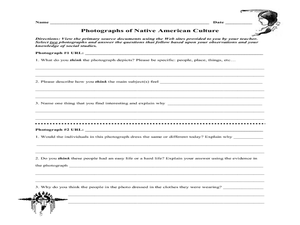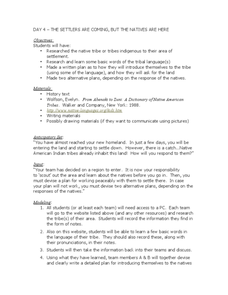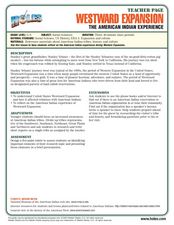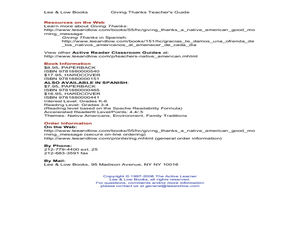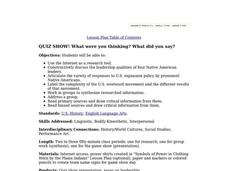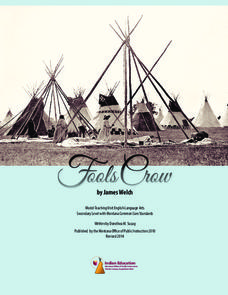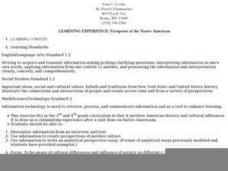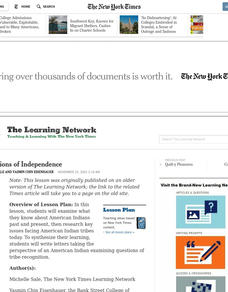Curated OER
Native Americans of Rockland County
Students comprehend Native American cultures through the use of both secondary and primary sources. They explore and investigate Native Americans in New York State. Students are shown some old Indian arrowheads and they are challenged...
Curated OER
Whose Rite Is It?
The class explores and debates, from multiple perspectives, a petition to allow Hopi Indians to take golden eagle hatchlings from a federal wildlife sanctuary for use in a religious ceremony. Pupils defend their personal views on the...
Curated OER
Not Just Another Native American Lesson
Second graders focus on Native Americans through hands-on crafts. They also study various Native American tales and legends, geography, and fine arts of the different regions.
Curated OER
Native Americans and Giving
Young scholars explore the concept of philanthropy. In this Brother Eagle, Sister Sky: The Words of Chief Seattle lesson, students examine the plight of Native Americans and explore Native Americans' quest for the "common good."
Pace University
The Iroquois
During the early 1500s, parts of modern-day New York were inhabited by Eastern Woodland Native Americans. To learn about the daily life, value, and traditions of these tribes, fourth graders research the Iroquois. Groups select...
Curated OER
The Naming of a Native American
Learners read and discuss Native American legends. They examine how the Native American name came about.
Curated OER
Interpreting Quotes From Native Americans and European Americans
Students examine the relations between Native Americans and European Americans in the late 1700's and early 1800's. In this Native American history lesson, students read and analyze quotes from Atiatoharongwen, Tecumseh, Thomas...
Curated OER
Native Americans
Learners determine how Native Americans were stripped of their cultures. In this Native American history lesson, students analyze several photographs of Native Americans and respond to questions about the photographs. Learners discuss...
Curated OER
Ann Arbor Growth & Immigration
Third graders describe some of the factors that brought early settlers to Ann Arbor. They read Narrative-A Trip from Utica, New York, to Ingham County, Michigan in 1838. As an added challenge, 3rd graders can use maps to track Silas...
Curated OER
The Settlers are Coming, but the Natives are Here
Students examine interactions between Native Americans and settlers. In this Westward Expansion lesson plan, students participate in a classroom simulation and then write paper about how the Native Americans and settlers could keep...
Curated OER
Westward Expansion: The American Indian Experience
Learners complete a brief presentation documenting the life of an American Indian. In class, students discuss the pros and cons of placing American Indians on a reservation. After their discussion, learners choose a issue in Native...
Curated OER
A Historic Gamble
Young scholars explore and evaluate the economic impact of legalized gambling on Native American Indian communities. They draft short, persuasive speeches that take the perspective of a tribal elder appearing at a town council meeting.
Curated OER
Lee & Low Books: Giving Thanks Teacher's Guide
Fourth graders participate in reading comprehension activities associated from a teacher's guide. In this reading comprehension lesson, 4th graders read Giving Thanks: A Native American Good Morning Message by Chief Jake Swamp and...
Curated OER
QUIZ SHOW! What were you thinking? What did you say?
Students participate in a game show to share the information they have uncovered about the US expansion policy and how it affected Native Americans.
Curated OER
James Welch's Fools Crow
Learners explore the history of Montana's Native Americans by reading James Welch's Fools Crow. Set shortly after the Civil War, the novel focuses on a young Blackfoot Indian and his tribe. Over the course of several weeks, class members...
Curated OER
Viewpoint of the Native American
Students compare how Native Americans were treated long ago to how they are treated today. They write an essay from the perspective of a Native American from their time period explaining their side with details supporting their views.
Curated OER
Survival of Native American Culture
Students research the five tribes of the Iroquois Nation focusing on housing, food, clothing, transportation, religion, and language. They research using Internet sources and book mark sites for reuse.
Curated OER
Declarations of Independence
Learners examine what they know about American Indians past and present, then research key issues facing American Indian tribes today. To synthesize their learning, students write letters taking the perspective of an American Indian.
Curated OER
The Finish Line
Students investigate the philanthropy of various cultural traditions. In this cultural education lesson, students read a handout about Native American, European American, and African American traditions and identify the philanthropic...
Curated OER
Pooling Common Knowledge
Fifth graders examine Native American cultures. In this diversity lesson, 5th graders prepare oral reports based on the research they conduct regarding Native American clothing, holidays, and sports.
Curated OER
Global Diversity Through Literature
Students investigate Southwest Indian Reservations. In this Native American lesson, students research Southwest Indian tribes on the Internet and by reading the book, Arrow to the Sun.
Curated OER
Searching the Net
Students create a Native American Nation flip book. In this Native American instructional activity, students choose one of four Native American Nations: The Iroquois, Hopi, Seminoles, Sioux. They research them on the Internet using...
New York City Department of Education
Geography and Early Peoples of the Western Hemisphere
Young historians discover the early people of the western hemisphere. The unit explores how the land changed, how it was used and homes of early Americans such as Incas, Mayans, Inuits, Aztecs, and Pueblos. Individuals also examine these...
City University of New York
African Americans and the Populist Movement
Why did the Populist Party fail to ally itself with African American farmers? To answer this essential question, class members investigate the Populist Era (188-1900) and read an article written by Tom Watson, a Populist leader.








